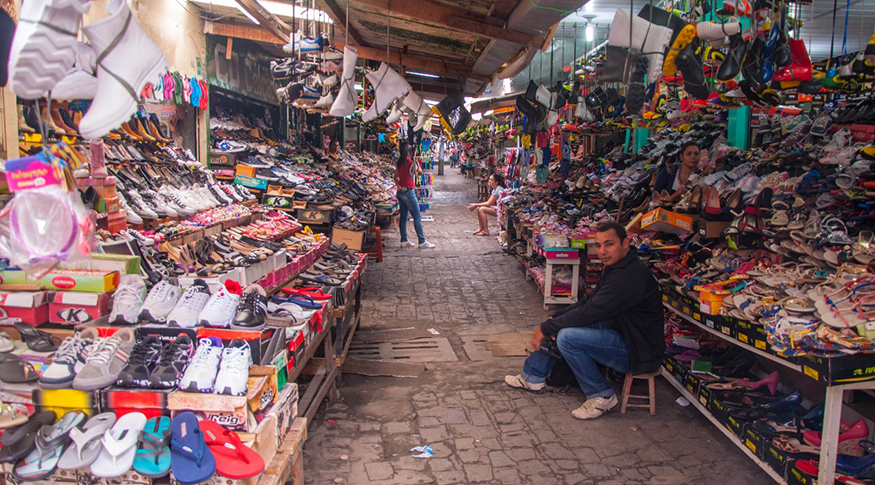Novel Coronavirus
Survey shows how people used to move around to go shopping before the pandemic
May 21, 2020 10h00 AM | Last Updated: May 29, 2020 05h51 PM
Highlights
- Data refer to 2018 and comprise the population that needs to leave the municipality where they live to buy clothing and shoes; and furniture and appliances.
- The average travel distance is 73 km to acquire electronics and furniture in other urban centers. This number is close to the average distance traveled for the acquisition of clothing and shoes (78 km).
- Amazonas is the state with the highest average travel both for the purchase of clothing and shoes and for electronics and furniture, with 342 km and 388 km, respectively. The lowest average traveled is in Santa Catarina, with 33 km and 36 km.
- The city of Goiânia is one the biggest hubs of municipalities (161) for the purchase of clothing and shoes.
- São Paulo stands out in the clothing and footwear trade, in addition to furniture and electronics.
The IBGE releases today (21) the survey Areas of Influence of Cities (Regic) 2018 – Information on Trade flows, with preliminary data, analyzes and regionalizations that identify cities that function as commercial centers for the purchase of clothes, shoes, furniture, appliances and electronics. The data, for 2018, were anticipated in order to contribute to the diagnoses of the economic impact of Covid-19. Soon, the information will also be made available on interactive maps, on the microsite covid19.ibge.gov.br/
The survey shows that the average travel of Brazilians who had to leave their municipality to buy electronics and furniture was 73 km. As for clothing and footwear, this average increases to 78 km. According to the survey, the demands of cities far from big urban centers are often met over the internet, but there are places that attract people from greater distances, for having diversified electronic commerce, for example.
With the current social distancing, there have been changes in the geographic pattern of consumption because of the reduction in commercial activity and restrictions to travels to/from municipalities. According to the IBGE manager of Geographic Networks and Flows, Mr. Bruno Hidalgo, the survey can contribute to a more detailed diagnoses of the specific impact for the cities that function as trade centers.
"Cities that are recurring destinations for purchases of items searched by the survey may suffer a reduction in specific sales during this pandemic as a result of receiving fewer consumers than usual," he explains.
Part of these negative repercussions on trade can be seen in the results of the IBGE's Monthly Survey of Trade (PMC), which show that retail sales dropped 2.5% in March 2020 compared to February. The drop was even greater in the items analyzed in Regic's trade items: fabrics, clothing and footwear had a 42.2% decrease in sales volume and the furniture and household appliances had a 25.9% sales reduction. In March 2020, these two sectors represented 4.5% and 8.4%, respectively, of the national retail, according to the PMC.
Regic also has an attraction index, which indicates the potential number of people that a city can attract to purchase a certain good or service. The index is calculated based on interviews with population living in the municipalities and the percentage of destinations. In this regard, in relation to the clothing and footwear trade, among the identified trade hubs, there are the opposite extremes of São Paulo (SP) and São Francisco de Goiás (GO), the municipality with the lowest attraction index.
Among the most attractive city hubs for clothing and footwear purchases, the population arrangement of Goiânia (GO) concentrates the largest number of municipalities (161), attracting consumers from great distances, such as Tocantins, southeastern Pará, northern Mato Grosso and western Bahia. The second major hub in this respect is the city of Caruaru (PE), followed by Feira de Santana (BA).
Among the hubs identified as a destination for clothing and footwear purchase, the population arrangement of Franca (SP), the municipality of Jaú (SP), the population arrangement of Brusque (SC), Tobias Barreto (SE), Santo Antônio de Jesus (BA), Cianorte (PR), Divinópolis (MG), Santa Cruz do Capibaribe (PE) and Toritama (PE).

North Region presents the longest distance traveled for cloting and footwear purchase
While in the North region, polarized by the municipality of Manaus (AM) and by the population arrangement of Belém (PA), the distances to be covered for the acquisition of clothing and shoes, on average, exceed 160 km, the distances traveled in the states of the Southeast and most states in the South and Northeast Regions are around 50 km to 75 km. The exception is Tocantins, which keeps an average of 85 km to 95 km from its neighbors Maranhão, Piauí and Bahia.
The highest average distance traveled to buy clothing and shoes occurs in Amazonas, with 342 km, almost exclusively headed to the capital. The lowest occurs in Santa Catarina, with an average of 33 km, where there are many intermediate hubs (regional capitals, sub-regional centers and zone centers).
The distance traveled by the population arrangement of Goiânia (GO), which attracts the largest number of municipalities in the country, is on average 403 km.
Manaus Free Trade Zone attracts population to buy electronics in Amazonas
The distances traveled from the cities of Amazonas for the purchase of electronics and furniture (388 km) is twice as long as the second longest average distance, recorded in Mato Grosso (181 km). This is due to the fact that there are few intermediate cities to meet the state's demand. In addition, there is the Manaus Free Trade Zone, where there is specialized manufacturing and trade of electronics. Seven cities in western Pará and Boa Vista (RR) also indicated Manaus (AM) as a destination for this type of purchase.
Rondônia, in turn, with a greater presence of intermediate cities - such as Cacoal (RO), Ji-Paraná (RO) and Ariquemes (RO) - attracts the smaller cities nearby and presents an average distance of 114 km, three times lower than the Amazonian average for the purchase of furniture and electronics.
The second state with the highest average distance traveled between cities for shopping for electronics and furniture is Mato Grosso, totaling 181 km. The state usually presents distance averages more similar to those found in the North region than to the other states in the Central-West region, mainly due to the pattern of displacements found in the east of the state.
At an intermediate level, Tocantins, Maranhão, Goiás and Piauí showed similar averages of trips for purchases of electronics and furniture (between 85 km and 95 km), almost the same for most states in the Northeast, South and Southeast with average trips of 45 km to 75 km.
The highlight for short distances, as well as shopping for clothing and shoes, were Santa Catarina, with only 36 km and Paraíba, with 38 km. In the latter, the population arrangements of Campina Grande (PB) and Patos (PB) were central points of reference for the purchase of electronics by neighboring cities, reducing the need for greater distance travels.
Checking the most attractive cities for purchases of electronics and furniture - besides to São Paulo (SP) and Manaus (AM) - the highlights are Carmo do Cajuru (MG) and the population arrangements of Ubá (MG) and São Bento do Sul (SC)/Rio Negrinho (SC), in addition to border cities, such as the international population arrangements of Foz do Iguaçu (Brazil)/Ciudad del Este (Paraguay) and Pedro Juan Caballero (Paraguay)/Ponta Porã ( Brazil).


















